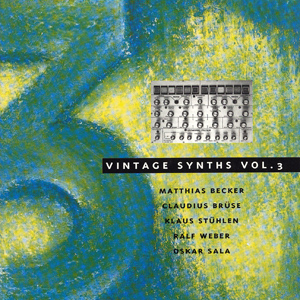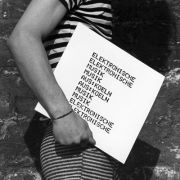
VINTAGE SYNTHS VOL. 3
Matthias Becker/ Claudius Brüse/ Klaus Stühlen/ Ralf Weber/ Oskar Sala
1. Steiner-Parker Synthacon (3:35)
Despite not being modular this compact american instrument offers comprehensive possibilities for modulations of any kind. Its multimode filter gives the instrument a quite unique and characteristic sound. The noises were put into groove via sampling because the instrument did not offer a MIDI interface.
2. Emu Modular System (3:50)
This extremely rare modular system is well known for the tuning stability of its oscillators and its excellent filters. The tracks "wood" and "metal" sounds were generated with the systems ring modulator, the sound of the solo line was changed in realtime during recording by tweaking the knobs of the resonant filter. No samples were used at all but the system was controlled by a Roland MPU-101 MIDI- Interface und C-LAB Notator
Software.
3. Roland SH-2000 (1:12)
Many of the sounds produced here by this small monophonic synth are very similar to some of those first made famous by "Switched On Bach" composer Wendy Carlos. The track was recorded with one shot samples and the aid of C-LAB's NOTATOR software.
4. Buchla Modular System 100 (2:11)
This composition with Don Buchlas first modular synthesizer from 1969 came into being without MIDI or computer.The main ingredient of the track are noises of different colours which start grooving thanks to a Roland 700 sequencer. A click track on the 24-track is fed into the
sequencer's pulse shaper and thus controls the synchronization of the many different layers. Note the extremely wide stereo image achieved with the aid of QSOUND.
5. SCI Prophet T-8 (3:28)
The largest model out of Sequential's series of analogue synthesizers persuades with powerful brass sounds and a solo line with a sync lead sound similar to those of Jan Hammer fame. The instruments overall sound is very similar to this of its "little brother" the Prophet 5. Recorded
with the aid of MIDI and computer.
6. Yamaha TX 816/ DX 7 (4:34)
This composition was produced with a Yamaha TX 816 expander which in regard to its sonic potential can be seen as 8 complete DX 7 synthesizers. The track features the large and until today not yet fully explored sonic potential of FM-synthesis. As an homage to the late writer
Phillip K.Dick Claudius Brüse entitled his composition "Do Androids Dream of Electric Sheep?".
7. Yamaha GS2 (2:48)
Only standard factory presets were used for the realisation of this composition. Most convincing are the brass and string sounds of the GS-2, but the noise inherent in the 8-bit FM-technology of this instrument is so loud that even DINR failed in removing it completely.
8. Mixtur Trautinium: Agitato (2:24)
This excerpt from SUITE FÜR MIXTUR-TRAUTONIUM UND ELEKTRONISCHES SCHLAGWERK of the CD RESONANZEN (ORIGINALTON WEST OW 028) once more demonstrates the incredible sonic potential of the Mixtur- Trautonium.The track was recorded in 1970 by Oskar Sala using the original valve instrument in combination with overdubbing techniques - and of course without MIDI or computer. The track appears on this CD by courtesy of SELECTED SOUND MUSIKVERLAG GmbH.
9. Mixtur-Trautonium: Meditation (2:01)
This track also comes from the CD RESONANZEN and - just as track 8 - has been digitally restored in a masterly way by Claudius Brüse. Though still working with valves instead of transistors the Mixtur- Trautonium on this track sounds as exciting, unusual and modern as only few of todays electronic instruments. Last not least thanks to the uncomparable performance of its only true virtuoso: Mr. Oskar Sala.
10. RMI Harmonic (2:40)
Because of its special way of sound generation (digital oscillators) the RMI Harmonic offers very characteristic and unique sound colours. As the instrument was not midified we made extensive use of one shot samples.
11. Oberheim X-pander (5:52)
This instrument persuades by its modulation possibilities. Many of the voices were modulated by slow envelopes and/or LFOs in order to slowly change their timbres. Thanks to overdubbing techniques the track was realized with exactly 18 single voices i.e. one X-pander and 2 ghostbrothers".
12. Gleeman Pentaphonic (2:56)
Gleeman's Pentaphonic is a 5-voice instrument with a sound which - to a certain extent - reminds the listener of the Prophet 5 by Sequential Circuits though its modulation possibilities are not as powerful as those of its famous colleague. Realized via one shot samples and C-LAB
NOTATOR.
13. Oberheim OB-8 (2:57)
This composition presents once more the typical strength of the Oberheim synthesizers: convincing brass and string sounds as well as interesting percussion timbres. Realized with the integrated MIDI-interface and C-LAB NOTATOR.
14. Korg PS-3300 (2:53)
Though this "Rolls-Royce" of Korg's PS series is playable fully polyhonic it also can be - as clearly demonstrated here - used for the generation of experimental timbres of many kinds. The track was recorded without MIDI; the basic timing was taken from a LFO modulation, the
echoes were supplied by a LEXICON JAM MAN.
15. Variophon (2:06)
This monophonic instrument is solely dedicated to the generation of brass sounds. It is played either by a melodica-like interface (a kind of flute with a keyboard) or via keyboard with breath-controller (which both are built especially for the use with this instrument). Except a portamento function (which has not been used here) and a pedal for wah-wah like effects there a no additional controllers at all. Vibrato, volume and timbre all have to be controlled via the breath controller. The composition was recorded track by track on a MTR machine and in order to keep the "human feel" we did not make use of a dedicated clicktrack.
16. Crumar DS-2 (3.33)
The italian Crumar DS-2 is a flexible and rather underrated instrument thats capable of the generation of powerful bass lines as well as - thanks to his two independant LFO's - very complex modulation sounds.
17. Roland JX-8P (2:38)
ROLAND's JX-8P persuades by warm and powerful sounds of a quality comparable to this of the Oberheim range. Despite the programming of the JX-8P being a lot more difficult than this of a Oberheim PB-8 or OBX-A the Roland still might be worth a try, as our example shows.
Recording via MIDI and C-LAB NOTATOR.
18. SCI Prophet VS (5:50)
A very expressive instrument in matters of sound which on one hand offers softer timbre transitions than a PPG 2.2/2.3 while on the other hand it is not able of the "wild" sound changes a PPG can perform. The composition ist based solely on the note C# with all transitions directly
depending on the harmonic series of this note.
